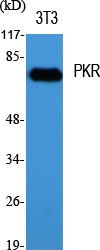Phospho PKR (T446) Cell-Based Colorimetric ELISA Kit
- Catalog No.:KA1640C
- Applications:ELISA
- Reactivity:Human
- Gene Name:
- EIF2AK2
- Human Gene Id:
- 5610
- Human Swiss Prot No:
- P19525
- Mouse Swiss Prot No:
- Q03963
- Storage Stability:
- 2-8°C/6 months
- Other Name:
- Interferon-induced, double-stranded RNA-activated protein kinase (EC 2.7.11.1) (Eukaryotic translation initiation factor 2-alpha kinase 2) (eIF-2A protein kinase 2) (Interferon-inducible RNA-dependent protein kinase) (P1/eIF-2A protein kinase) (Protein kinase RNA-activated) (PKR) (Tyrosine-protein kinase EIF2AK2) (EC 2.7.10.2) (p68 kinase)
- Detection Method:
- Colorimetric
- Background:
- catalytic activity:ATP + a protein = ADP + a phosphoprotein.,enzyme regulation:Activity is markedly stimulated by manganese ions. Besides dsRNA, heparin is a potent activator of the kinase. Binding to dsRNA is required for dimerization leading to autophosphorylation in the activation loop and stimulation of function. Inhibited by vaccinia virus protein E3, probably via dsRNA sequestering.,function:Following activation by double-stranded RNA in the presence of ATP, the kinase becomes autophosphorylated and can catalyze the phosphorylation of the translation initiation factor EIF2S1, which leads to an inhibition of the initiation of protein synthesis. Double-stranded RNA is generated during the course of a viral infection.,induction:By interferon.,PTM:Autophosphorylated on several Ser and Thr residues. Autophosphorylation of Thr-451 is dependent on Thr-446 and is stimulated by dsRNA binding and dimerization. Autophosphorylation apparently leads to the activation of the kinase.,similarity:Belongs to the protein kinase superfamily.,similarity:Belongs to the protein kinase superfamily. Ser/Thr protein kinase family. GCN2 subfamily.,similarity:Contains 1 protein kinase domain.,similarity:Contains 2 DRBM (double-stranded RNA-binding) domains.,subunit:Homodimer. Interacts with STRBP (By similarity). Interacts with DNAJC3. Inhibited by direct interaction with viral proteins such as HCV E2, HCV NS5A and influenza A NS1. Activated by the interaction with HIV-1 Tat.,
- Function:
- translation, protein amino acid phosphorylation, phosphorus metabolic process, phosphate metabolic process,apoptosis, virus-infected cell apoptosis, ER-nuclear signaling pathway, response to unfolded protein, cell death,negative regulation of cell proliferation, response to virus, response to organic substance, programmed cell death,death, phosphorylation, endoplasmic reticulum unfolded protein response, cellular response to stress, regulation of osteoblast proliferation, negative regulation of osteoblast proliferation, cellular response to unfolded protein,response to endoplasmic reticulum stress, regulation of cell proliferation, protein amino acid autophosphorylation,response to protein stimulus,
- Subcellular Location:
- Cytoplasm . Nucleus . Cytoplasm, perinuclear region . Nuclear localization is elevated in acute leukemia, myelodysplastic syndrome (MDS), melanoma, breast, colon, prostate and lung cancer patient samples or cell lines as well as neurocytes from advanced Creutzfeldt-Jakob disease patients. .
- Expression:
- Highly expressed in thymus, spleen and bone marrow compared to non-hematopoietic tissues such as small intestine, liver, or kidney tissues. Colocalizes with GSK3B and TAU in the Alzheimer disease (AD) brain. Elevated levels seen in breast and colon carcinomas, and which correlates with tumor progression and invasiveness or risk of progression.
- June 19-2018
- WESTERN IMMUNOBLOTTING PROTOCOL
- June 19-2018
- IMMUNOHISTOCHEMISTRY-PARAFFIN PROTOCOL
- June 19-2018
- IMMUNOFLUORESCENCE PROTOCOL
- September 08-2020
- FLOW-CYTOMEYRT-PROTOCOL
- May 20-2022
- Cell-Based ELISA│解您多样本WB检测之困扰
- July 13-2018
- CELL-BASED-ELISA-PROTOCOL-FOR-ACETYL-PROTEIN
- July 13-2018
- CELL-BASED-ELISA-PROTOCOL-FOR-PHOSPHO-PROTEIN
- July 13-2018
- Antibody-FAQs

